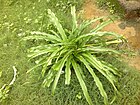Note: This is a project under development. The articles on this wiki are just being initiated and broadly incomplete. You can Help creating new pages.
Difference between revisions of "Crinum latifolium - Sudarsana"
(Created page with "thumb|right|''Sudarsana'', ''Crinum latifolium'' '''Sudarsana'''is a bulbous plant with lance shaped leaves and beautiful bell shaped white...") |
(→External Links) |
||
| Line 94: | Line 94: | ||
[[Category:Herbs]] | [[Category:Herbs]] | ||
[[Category:Plants of western ghats]][[Category:Herb]] | [[Category:Plants of western ghats]][[Category:Herb]] | ||
| + | [[Category:Ayurvedic herbs that don't have flower, fruit and leaf photos]] | ||
| + | [[Category:Ayurvedic herbs that don't have seed photos]] | ||
Revision as of 12:56, 15 May 2019
Sudarsanais a bulbous plant with lance shaped leaves and beautiful bell shaped white flowers. The plant stays dormant for several months of the year, leaves and flowers appear before the monsoon.
Contents
- 1 Uses
- 2 Parts Used
- 3 Chemical Composition
- 4 Common names
- 5 Properties
- 6 Habit
- 7 Identification
- 8 List of Ayurvedic medicine in which the herb is used
- 9 Where to get the saplings
- 10 Mode of Propagation
- 11 How to plant/cultivate
- 12 Commonly seen growing in areas
- 13 Photo Gallery
- 14 References
- 15 External Links
Uses
Fungal infections, Antidote for poisoning, Fever, Joint pain, Ear ache [1]
Parts Used
Chemical Composition
Common names
| Language | Common name |
|---|---|
| Kannada | visha mungali |
| Hindi | |
| Malayalam | sjovanna-pola-tali |
| Tamil | vishamungil |
| Telugu | |
| Marathi | gadambhikanda, gandani-kanda, golkamdo, gul-sabu |
| Gujarathi | NA |
| Punjabi | NA |
| Kashmiri | NA |
| Sanskrit | cakrangi, daddhyali, sudarsana |
| English | NA |
Properties
Reference: Dravya - Substance, Rasa - Taste, Guna - Qualities, Veerya - Potency, Vipaka - Post-digesion effect, Karma - Pharmacological activity, Prabhava - Therepeutics.
Dravya
Rasa
Tikta (Bitter), Madhura (Sweet)
Guna
Rooksha (Dry), Teekshna (Pungent)
Veerya
Ushna (Hot)
Vipaka
Karma
Kapha, Vata
Prabhava
Habit
Identification
Leaf
| Kind | Shape | Feature |
|---|---|---|
| Simple | rootstock bulbous, ca. 6 cm across. Leaves many, densely clustered, 30-45 x 7-8 cm, flat or widely channelled, oblong, curved, acute or obtuse; sheath closed, membranous. |
Flower
| Type | Size | Color and composition | Stamen | More information |
|---|---|---|---|---|
| Unisexual | Stout peduncled umbel | White and pink | 10 | Flowers sessile, 12-16 together, on stout peduncled umbel; peduncle 50-60 cm high, thick; spathe membranous; perianth tube 7 cm long, narrow, lobes 6, 8 x 2.5 cm, oblong, acute, pinkish white, spreading or deflexed; stamens 6, filaments long, attached at the throat of perianth tube; anthers 12 mm long, linear. |
Fruit
| Type | Size | Mass | Appearance | Seeds | More information |
|---|---|---|---|---|---|
| A capsule | oblong | seeds many | {{{6}}} |
Other features
List of Ayurvedic medicine in which the herb is used
Where to get the saplings
Mode of Propagation
How to plant/cultivate
Season to grow
Soil type
Propagation
Commonly seen growing in areas
Photo Gallery
References
External Links
Categories:
- Ayurvedic Herbs known to be helpful to treat Fungal infections
- Ayurvedic Herbs known to be helpful to treat Antidote for poisoning
- Ayurvedic Herbs known to be helpful to treat Fever
- Ayurvedic Herbs known to be helpful to treat Joint pain
- Ayurvedic Herbs known to be helpful to treat Ear ache
- Herbs with Leaves used in medicine
- Herbs with Rhizome used in medicine
- Herbs with common name in Kannada
- Herbs with common name in Malayalam
- Herbs with common name in Tamil
- Herbs with common name in Marathi
- Herbs with common name in Sanskrit
- Habit - Herb
- Index of Plants which can be propagated by Seeds
- Index of Plants which can be propagated by Bulbs
- Herbs that are commonly seen in the region of Tropical area
- Herbs
- Plants of western ghats
- Herb
- Ayurvedic herbs that don't have flower, fruit and leaf photos
- Ayurvedic herbs that don't have seed photos




